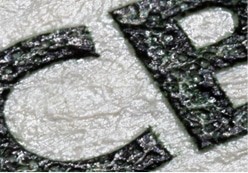How do you detect it?
A product Fingerprint (or Unique Fingerprint) requires an imaging device and a computing device to acquire an image of each product item and to compare it to the reference fingerprint. In some cases, smartphones can be used to do so.
How does it work?
To protect a product with a fingerprint, an imaging system acquires an image of the product and/or its surface. This fingerprint image is then processed and stored in a database as the fingerprint reference. During authentication, an image is taken of the product under investigation. The image is again processed and then compared to the reference stored in the template. A similarity metric is in general used to determine if the product is authentic or not.
What do we think about this technology?
This approach is theoretically optimal in many ways, since it is practically impossible to counterfeit, does not impact the product in any way and can be authenticated using smartphones. However, its implementation is challenging at large scale, since it requires taking individual pictures of each item in real time, knowing that any problem will slow down or even stop production. Moreover, authentication requires connectivity and can be extremely slow, since each item needs to be looked up in a vast collection of images. Faster detection can nevertheless be achieved if complementary information is also printed on the box. However, that adds yet another layer of complexity and makes it even less suitable for real-world deployment scenarios (all the ones we know have failed). If serialization is needed, then nothing beats a simple variable QR code printed in ink or laser-engraved.
In addition, if an authentication feature is required, you can supplement the QR code with an AlpVision Fingerprint® or a Cryptoglyph®. AlpVision provides software solutions to integrate serialization and authentication methods.
This technologie is well suited to fight against gray market.
Field of application
Manufactured products, packaging, luxury goods and organic materials.

